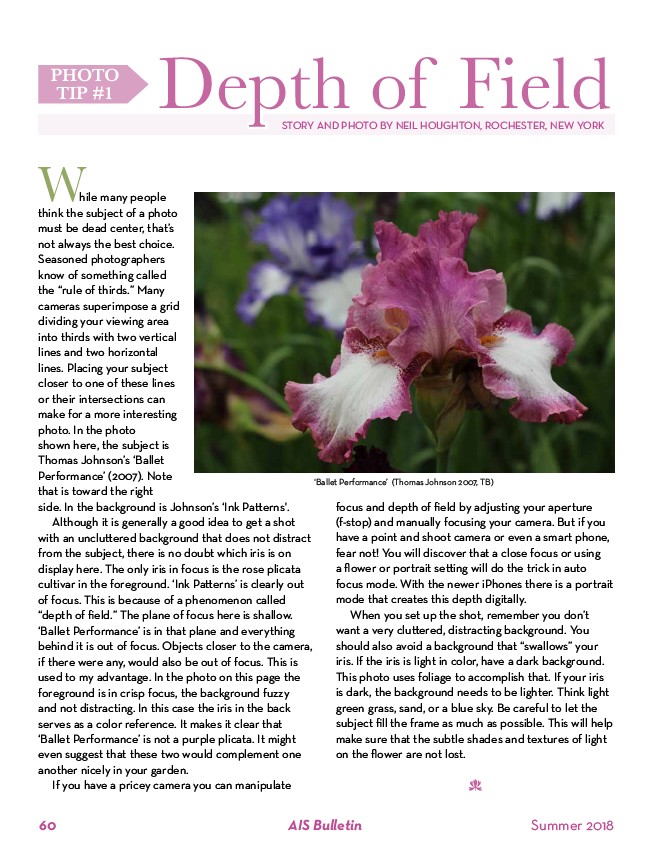
Depth of Field
STORY AND PHOTO BY NEIL HOUGHTON, ROCHESTER, NEW YORK
PHOTO
TIP #1
While many people
think the subject of a photo
must be dead center, that’s
not always the best choice.
Seasoned photographers
know of something called
the “rule of thirds.” Many
cameras superimpose a grid
dividing your viewing area
into thirds with two vertical
lines and two horizontal
lines. Placing your subject
closer to one of these lines
or their intersections can
make for a more interesting
photo. In the photo
shown here, the subject is
Thomas Johnson’s ‘Ballet
Performance’ (2007). Note
that is toward the right
side. In the background is Johnson’s ‘Ink Patterns'.
Although it is generally a good idea to get a shot
with an uncluttered background that does not distract
from the subject, there is no doubt which iris is on
display here. The only iris in focus is the rose plicata
cultivar in the foreground. ‘Ink Patterns’ is clearly out
of focus. This is because of a phenomenon called
“depth of field.” The plane of focus here is shallow.
‘Ballet Performance’ is in that plane and everything
behind it is out of focus. Objects closer to the camera,
if there were any, would also be out of focus. This is
used to my advantage. In the photo on this page the
foreground is in crisp focus, the background fuzzy
and not distracting. In this case the iris in the back
serves as a color reference. It makes it clear that
‘Ballet Performance’ is not a purple plicata. It might
even suggest that these two would complement one
another nicely in your garden.
If you have a pricey camera you can manipulate
‘Ballet Performance’ (Thomas Johnson 2007, TB)
focus and depth of field by adjusting your aperture
(f-stop) and manually focusing your camera. But if you
have a point and shoot camera or even a smart phone,
fear not! You will discover that a close focus or using
a flower or portrait setting will do the trick in auto
focus mode. With the newer iPhones there is a portrait
mode that creates this depth digitally.
When you set up the shot, remember you don’t
want a very cluttered, distracting background. You
should also avoid a background that “swallows” your
iris. If the iris is light in color, have a dark background.
This photo uses foliage to accomplish that. If your iris
is dark, the background needs to be lighter. Think light
green grass, sand, or a blue sky. Be careful to let the
subject fill the frame as much as possible. This will help
make sure that the subtle shades and textures of light
on the flower are not lost.
d
60 AIS Bulletin Summer 2018